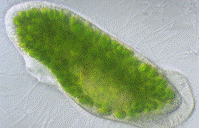Papers in the Biological Sciences
Document Type
Article
Date of this Version
2004
Citation
Antimicrobial Agents and Chemotherapy, June 2004, p. 1993–1999 Vol. 48, No. 6
Abstract
Mercury has a long history as an antimicrobial agent effective against eukaryotic and prokaryotic organisms.
Despite its prolonged use, the basis for mercury toxicity in prokaryotes is not well understood. Archaea, like
bacteria, are prokaryotes but they use a simplified version of the eukaryotic transcription apparatus. This
study examined the mechanism of mercury toxicity to the archaeal prokaryote Sulfolobus solfataricus. In vivo
challenge with mercuric chloride instantaneously blocked cell division, eliciting a cytostatic response at
submicromolar concentrations and a cytocidal response at micromolar concentrations. The cytostatic response
was accompanied by a 70% reduction in bulk RNA synthesis and elevated rates of degradation of several
transcripts, including tfb-1, tfb-2, and lacS. Whole-cell extracts prepared from mercuric chloride-treated cells
or from cell extracts treated in vitro failed to support in vitro transcription of 16S rRNAp and lacSp promoters.
Extract-mixing experiments with treated and untreated extracts excluded the occurrence of negative-acting
factors in the mercury-treated cell extracts. Addition of transcription factor B (TFB), a general transcription
factor homolog of eukaryotic TFIIB, to mercury-treated cell extracts restored >50% of in vitro transcription
activity. Consistent with this finding, mercuric ion treatment of TFB in vitro inactivated its ability to restore
the in vitro transcription activity of TFB-immunodepleted cell extracts. These findings indicate that the toxicity
of mercuric ion in S. solfataricus is in part the consequence of transcription inhibition due to TFB-1 inactivation.


Comments
Copyright © 2004, American Society for Microbiology. All Rights Reserved.